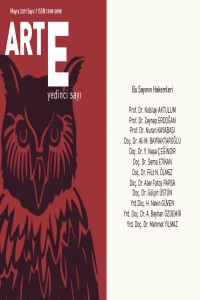Öz
Moda en genel tanımıyla değişimi ifade etmektedir. Genellikle giyim kuşamla eş anlamlı görülmesine rağmen insana dair her alanı kapsayan bir olgudur. Beğenilerdeki kısa ya da uzun vadeli değişimler moda eğilimlerini oluşturmaktadır.
Bu çalışmada moda kavramının sınırları çizilmeye çalışılmış moda kuramları moda eğilimi ve moda eğilimi çeşitleri kuramsal çerçevede ele alınmış ve güncel moda eğilimi analiz çalışmaları üzerinde durulmuştur.
Bu araştırmanın yöntemi betimsel yöntemdir. Araştırma verileri tarama yoluyla elde edilmiştir.
Bu çalışmada moda kavramı, genelde giyim kuşamla eş anlamlı kullanılsa da daha çok 'sembolik bir ürün' olarak tanımlanabileceği, moda kuramlarının ise bu söylem doğrultusunda şekillendiği görülmüştür. Araştırma konusuna yönelik yazın incelendiğinde konuya yönelik araştırma sayısının kısıtlı olduğu söylenebilir. Bu alanda dünyadaki diğer güncel çalışmalarla birlikte ve eşgüdümlü olarak yürütülebilecek çalışmaların, akademik moda yazınının önünün açılmasına ve gelişmesine vesile olacağı düşünülmektedir.
Anahtar Kelimeler: Moda, Giyim, Trend Analizleri, Moda Eğilimi, Moda Kuramları.
Abstract
Fashion, in broad sense, refers to a change. It is generally associated with clothing and dressing styles, however, it is a phenomenon that covers any area of people. Short or long term changes in preferences create trends in fashion. This study tries to determine the borders of fashion concept, fashion theories, fashion trend and kinds of trends have been studied and works of current analysis of fashion trend were sampled. The method of the study is the descriptive method and the data were collected by means of going over the documents.
This study emphasizes that the concept of fashion could only be defined as 'a symbolic product' When the literature is examined, it is found out that there is only a limited number of studies on the subject. Any future study in this field which are to be conducted in coordination with any other ones around the world will serve as a reason for opening the way for further academic studies on fashion.
Keywords: Fashion, Clothing, Trend Analysis, Fashion Trend, Theories of Fashion.
Anahtar Kelimeler
Kaynakça
- Aamodt, A. ve Plaza, E. (1994). Case-Based reasoning: Foundational issues, methodological variations, and system approaches. Al Communications, 7(1), 39-59.
- Blumer, H. (1969). Fashion: From class differentiation to collective selection. Sociological Quarterly, 10(3), 275-291.
- Breward, C. (2003). Fashion. Oxford: Oxford University Press.
- Butdee, S., N. Kongprasert ve C. Noomtong. (2007). Case-Based Antipication for Modern Fashion Trends. Proceedings of the l2th Annual International Conference on Industrial Engineering. Cancun: Mexico, 861-866.
- Cho, H. ve J. Lee. (2005). Development of a macroscopic model on recent fashion trends on the basis of consumer emotion. International Journal of Consumer Studies, 29(1), 17-33.
- Corbin, J. ve Strauss, A. (1990). Grounded Theory research. Procedures, canons, and evaluative criteria. Qualitative Sociology, 13(1), 13-21.
- Crane, D. (2003). Moda ve Gündemleri. (Ö. Çelik, Çev.). İstanbul: Ayrıntı Yayınları.
- Davis, F. (1997). Moda, Kültür ve Kimlik. (Ö. Arıkan, Çev.). İstanbul: Yapı Kredi Yayınları.
- Flügel, J. C. (1930). The Psychology of Clothes. Londra: Hogarth Press. Frings, G.S.( 2005). Fashion from Concept to Consumer. USA: Pearson Education Inc.
- Karasar, N. (2007). Bilimsel Araştırma Yöntemi. Ankara: Nobel Yayın Dağıtım.
- Kawamura, Y. (2005). Fashionology. New York: Berg.
- Keiser, S. J. ve M. B. Garner. (2003). Beyond Design. New York: Fairchild Publications, Inc.
- King, C. W. (1963). Fashion adoption: A rebuttal to the “Trickle Down” theory.
- Toward Scientific Marketing. (S. A. Greyser, Yay. Haz.).(ss. 108- 125).Chicago: American Marketing Association.
- King, C. W. ve L. J. Ring. (1980). The dynamics of style and taste adoption and diffusion: contributions and fashion theory. Advance in Consumer Research, 7(1), 13-16.
- Law, K. M., Z. Zhang ve C. Leung. (2004). Fashion change and fashion consumption: The chaotic perspective. Journal of Fashion Marketing and Management, 8(4), 362–374.
- T, Hines, M. Bruce (Yay. Haz.). Fashion Marketing . (ss. 168-187). Burlington: Elsevier Ltd. Jackson, T. (2007). The process of trend development leading to a fashion season
- Robinette, S., Brand, C., Lenz, V. (2002). Emotion Marketing: The Hallmark Way of Winning Customers for Life. New York: McGraw-Hill. Rüling, C. C. (2000). Theories of (Management?) Fashion: The
- contributions of Veblen, Simmel, Blumer, and Bourdieu. 18 Nisan
- tarihinde http:/hec.info.unige.ch/recherches.publications/cahiers/
- /2000.01.pdf adresinden erişildi
- Senes, A. (1997). New York: Haute pressin a Manhattan. Le Monde, 16 Ekim, Styles, s.6.
- Simmel, G. (2003). Moda feslefesi (T. Bora, Çev.). Modern Kültürde Çatışma içinde. (ss. 103-134). İstanbul: İletişim Yayınları.
- Sproles, G. B. (1981). Analyzing fashion life cycles: principles and perspectives. The Journal of Marketing, 45(4), 116–124. 9 Mart 2010 tarihinde JSTOR veritabanından erişildi.
- Veblen, T. (2005). Aylak Sınıfın Teorisi. (C. Atay, Z. Gültekin, Çev.). Ankara: Babil Yayıncılık.
- Watson, L. (2007). Modaya Yön Verenler. (G. Ayas, Çev.). İstanbul: Güncel Yayıncılık.
Ayrıntılar
| Birincil Dil | Türkçe |
|---|---|
| Bölüm | Makaleler |
| Yazarlar | |
| Yayımlanma Tarihi | 17 Haziran 2011 |
| Gönderilme Tarihi | 17 Haziran 2011 |
| Yayımlandığı Sayı | Yıl 2011 Cilt: 4 Sayı: 7 |


